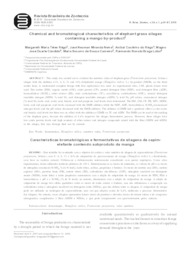Chemical and bromatological characteristics of elephant grass silages containing a mango by-product.
Chemical and bromatological characteristics of elephant grass silages containing a mango by-product.
Autoria: RÊGO, M. M. T.; NEIVA, J. N. M.; RÊGO, A. C. do; CÂNDIDO, M. J. D.; CARNEIRO, M. do S. de S.; LOBO, R. N. B.
Resumo: This study was carried out to evaluate the nutritive value of elephant grass (Pennisetum purpureum, Schum.) silages with the addition of 0, 4, 8, 12 and 16% dehydrated mango (Mangifera indica, L.) by-product (DMB), on the fresh matter basis. A randomized complete design with four replications was used. As experimental silos, 210L plastic drums were used. Dry matter (DM), organic matter (OM), crude protein (CP), neutral detergent fiber (NDF), acid detergent fiber (ADF), hemicellulose (HCEL), ether extract (EE), total carbohydrates (TC), non-fibrous carbohydrates (NFC), neutral detergent insoluble nitrogen (NDIN, % total N), acid detergent insoluble nitrogen (ADIN, % total N), pH values, ammoniacal nitrogen (% total N), lactic acid, acetic acid, butyric acid and propionic acid levels were determined. The DM, OM, CP, EE, NFC, NDIN, lactic acid and propionic acid levels increased with the DMB addition while the NDF, ADF, hemicellulose, N-NH3/ammoniacal nitrogen levels and the pH values decreased with the DMB addition. The addition of DMB had a quadratic effect on the acetic and butyric acid levels but there was no effect with the addition of DMB on TC and ADIN. The DMB can be used at the ensiling of the elephant grass, because the addition of 8.6% improves the silages fermentative process. However, these silages have low crude protein levels and high contents of ether extract and nitrogen compounds mixed with the fiber (NDIN and ADIN) in the silages, that may damage their use by animals.
Ano de publicação: 2010
Tipo de publicação: Artigo de periódico
Unidade: Embrapa Caprinos e Ovinos
Palavras-chave: Animal byproducts, Fermentation, Fermentação, Manga, Mangifera Indica, Nutritive value, Pennisetum Purpureum, Subproduto, Valor nutritivo
Observações
1 - Por padrão são exibidas publicações dos últimos 20 anos. Para encontrar publicações mais antigas, configure o filtro ano de publicação, colocando o ano a partir do qual você deseja encontrar publicações. O filtro está na coluna da esquerda na busca acima.
2 - Para ler algumas publicações da Embrapa (apenas as que estão em formato ePub), é necessário ter, no celular ou computador, um desses softwares gratuitos. Sistemas Android: Google Play Livros; IOS: iBooks; Windows e Linux: software Calibre.
Acesse outras publicações
Acesse a Base de Dados da Pesquisa Agropecuária (BDPA) para consultar o acervo completo das bibliotecas da Embrapa.

